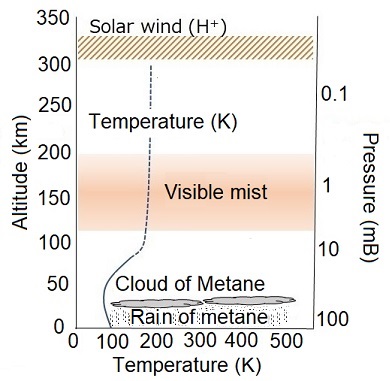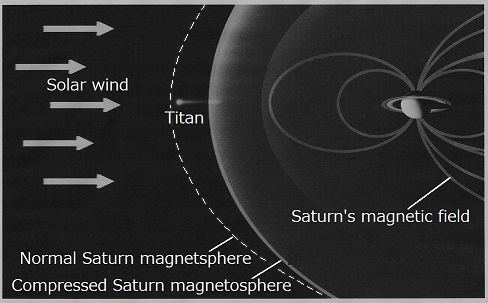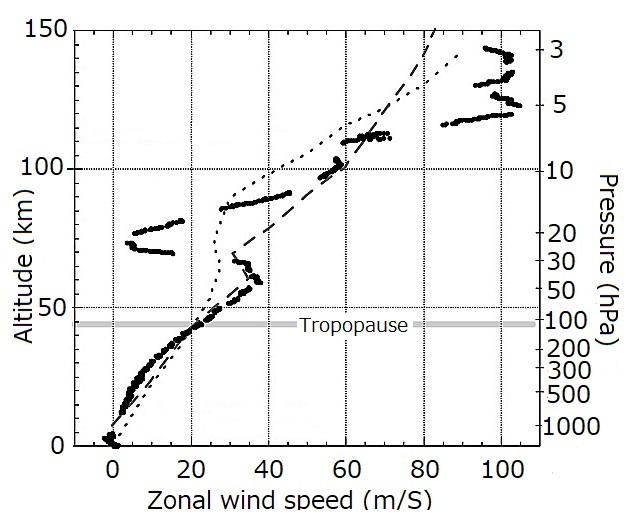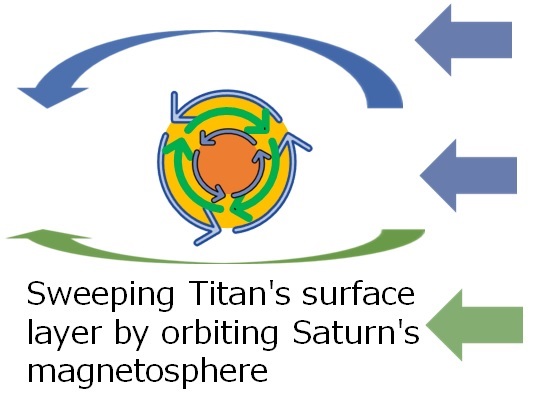2.5 Formation of lakes of methane in the Titan
- Titan's atmospheric superrotation -
2.5.1 Methane lakes in Titan
Cassini's probe has confirmed the existence of methane rivers and lakes,
with liquid methane rain on Titan. Fig. 2.5.1 shows the altitude distribution
of the temperature of Titan's atmosphere. Table 2.5.1 shows the temperature
characteristics of the atmospheric molecules present in Titan's surface
layer.
Titan's atmosphere is 1.45 atm on the surface. Titan has weaker gravity than Earth and has a troposphere up to 40km above it. Nitrogen (N2) accounts for 98.4% of Titan's atmosphere.
Since the boiling point of N2 is lower than the surface temperature of Titan, it exists as gases state.
Methane (CH4), which accounts for 1.4% of Titan's atmosphere,
is held as liquid state owing to Titan's temperature environment of the surface.。

Fig.2.5.1 Altitude distribution of temperature in Titan's atmosphere
[ Reproduced from https://www.kahaku.go.jp/exhibitions/vm/resource/tenmon/space/saturn/images/saturn_04.gif ]
Table. 2.5.1 Temperature characteristics of molecules in Titan’s surface layer
| Nitrogen (N2) | Methane (CH4) | Ammonia (NH3) | Carbon dioxide (CO2) | |
| >Melting point | 63.15 K (-210.0 °C) | 91 K (-182.5 °C) | 195 K (-77.7 °C) | 216.6K (-56.6 °C) |
| Boiling poin | 77.36 K (-195.8 °C) | 112 K (-161.6 °C) | 240 K (-33.3 °C) | 194.7 K (-78.5 °C) |
2.5.2 The origin of Titan's atmosphere
When H2O ice is generated on a cosmic dust by surface reaction, it does not leave the surface at temperatures below 100K [*1]. [*1] Kenji Furuya, "Generation and transport of water in the star-planetary system formation region, searched from deuterium ratio", Astronomical and Monthly Report, January 2018, pp.41-49. When fine particles of dust such as ammonia (NH3) and methane (CH4) come into contact with H2O ice, they adhere due to the microscopic force of intermolecular bonds, and the fine particles accumulate and grow into clumps. The growth of astronomical object prevents decompose owing to its gravitational force and low surface-energy. Gravitational energy is emitted when interstellar medium (ISM)is accumulated by the adhesion action of fine particles and becomes a celestial body. The amount of energy is half the gravitational potential according to the virial theorem. This temperature increases as ISM accumulates. To date, the total amount of gravity energy emitted by Titan due to the accumulation of ISM is (1/2) EG-potential= (1/2)(3/5)(GMTitan2) /RTitan=1.4045x1029 J. This energy value can be converted to an approximate temperature increase by using specific heat (Cp). Assuming that Titan's Cp is the same value of water (CpTitan=Cpwater=4.2 J・g-1・K-1), ΔTTitan=+334 K is calculated when the energy emitted by gravity so far is converted to temperature rise. In this way, molecules such as NH3and CH4 move from the inside to the surface layer.
2.5.3 Titan is swept by H+ via rotation of Saturn's magnetosphere
As shown in Fig. 2.5.2, the orbital radius from Saturn to Titan is 1.2 x106 km.
But the orbit is not in circle, at the facing side of Sun is 1.1 x106 km. Titan passes through Saturn's magnetosphere for most of the time.
Saturn's rotation causes the magnetosphere to orbit in 10.7 hours, and
the orbital speed of the magnetosphere at titan's orbit is 194 km/sec.
However, titans have an orbital period of about 16 days and the speed of
5.4 km/sec. The speed at which the magnetosphere sweeps the surface of
Titan is 186 km/sec. The kinetic energy of a H+ at the sweeping speed is
186 eV.
Fig.2.5.2 shows Titan's orbit passing through Saturn's magnetosphere.
Table 2.5.2 also shows data on Saturn's orbit and Titan's orbit.

Fig.2.5.2 Relationship between Titan's orbit and Saturn's magnetosphere
Reproduced from 26c9649364b5a5135cc5a1c394e92c78.jpg (1600×900) (goo.ne.jp)
Table 2.4.2 Data involved in the phenomenon of collision of H+ captured in Saturn's magnetosphere with the surface layer of the Titan.
| Radius | Cycle | Velosity | Difference of velosity | Kinetic energy | |
| Titan's orbit | 1.20x106 km | 16days | 5.4 km/sec | ||
| Saturn's rotation | Position of Titan | 0.445days | 194km/sec | 188.6km/sec | 186eV |
2.5.4 Super rotation of Titan
Fig. 2,5.3 shows the altitude distribution of Titan's atmospheric flow that is measured by the probe Huygens. Except around 80km altitude, Speed of the westerly winds are rising with the altitude. A model for the driving force of these flows is considered in which Saturn's magnetosphere sweeps Titan's surface layer as shown in Fig. 2.5.4. Since Saturn is far from the Sun, the density of the motion energy of the solar wind is reduced. There is the driving force caused by the rotation of Saturn's magnetosphere, which sweeps titan's surface layer.
The molecules in the atmosphere of Titan are ionized by the collision o fH+ and those ions are bundled by magnetic coupling,
and those rotate around the Titan.
The flows of the facing side to the Saturn are in the opposite direction against back sides.
The speed of flow on the back side to the Saturn is faster than that of front side. As the result,
the anti-clockwise wind of back side includes the clockwise wind of front side.
The maximum difference on the velocity (δv maxv max= 2π{(rTitan)/T=411 m/sec.
Bundles of ions moving in the opposite direction repel magnetically, forming a layer without disappearing.
So, we can explain the presence of an area with nearly zero westerly winds around 80 km.
Lowering the altitude below 80 km increases the density of the atmosphere,
which reduces the speed of the atmospheric orbit and finally the speed of Titan's surface.


Fig.2,5.3 Altitude distribution of Titan’s atmosphere [*2] Fig.2,5.4 Atmospheric
flows and magnetosphere motion
[*2} Fig.2.5.3 is reproduced from the paper, W. M. Folkner, et al, “Winds
on Titan from ground-based tracking of the Huygens probe”, Journal of Geophysical
Research: Planets, Volume: 111, Issue: E7, 20 July 2006, https://doi.org/10.1029/2005JE002649]
Index -2..8